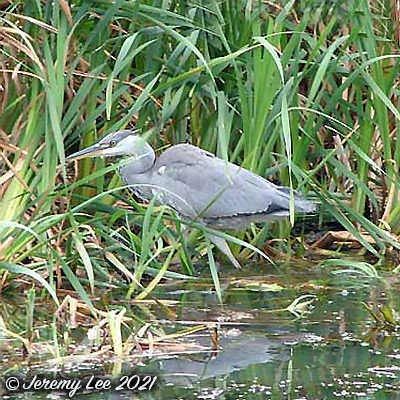
 |
|
Scientific Classifications explained » Amphibians » Ants » Aphids » Bees » Beetles » Birds » Bugs » Butterflies » Caterpillars » Damselflies » Dragonflies » Earwigs » Flies » Frog/Leafhoppers » Fungi » Galls » Grasshoppers » Harvestmen » Hoverflies » Lacewings » Ladybirds » Leaf Mines » Lichens » Mammals » Millipedes » Mosses » Moths » Sawflies » Slugs » Snails » Spiders » Trees & Shrubs » Wasps » Wild Flowers » Woodlice » Postboxes |
UK Nature > Birds > Ardea cinerea

Scientific Name: Ardea cinerea Common Name: Grey Heron Ardea cinerea, more commonly known as the Grey Heron, is the most abundant and widespread of Europe's herons, found on food-rich lakes, rivers, most other fresh waters and on sea shores. Usually nests in large, noisy colonies in trees near water. When hunting, stands motionless in wait for fish, which it captures with a lightning-fast bill stab. The patient watching behaviour and the stiffly held and often retracted neck are very characteristic of herons in general, but the Grey heron is easily distinguished from other European herons by its size and the grey, white and black plumage. In flight, the neck is always retracted and the bird looks positively front-heavy. Over long distances, the Grey Heron flies at high altitudes, and can then be confused with large birds of prey, because of its slow, heavy wing action. But even at long range, the Grey Heron's particular characteristics in flight are obvious: bowed wings that beat heavily and slowly. Its normal call is a raucous 'kaark'. |
|

https://www.uknature.co.uk is a website dedicated to showing the immense diversity of UK nature and wildlife. Our vast range of habitats, from lowland arable to snow covered mountains, from storm-ravaged coastlines to peaceful inland freshwater lakes and rivers, from dry, sandy heaths to deciduous and coniferous forests, all these habitats contribute to the abundance of UK nature. We have wild birds in huge numbers either residing or visiting our shores (597 recorded species as at July 2013) and we must also not forget the humble back garden with its grass lawns, flower beds filled with nectar rich flowers, shrubs and trees, all designed to attract huge numbers of insects such as bees, moths, butterflies and hoverflies; and finally the small ponds which provide safe havens for frogs, toads, newts and even slow worms and grass snakes. www.uknature.co.uk is the showcase for my personal passion, photographing uknature in all its glory. I sincerely hope you all enjoy the fruits of my labours. This site and all images contained therein is © Jeremy Lee 2004 - 2025. All Rights Reserved. Site design by Jeremy Lee. Site development & IT Support by Stuart Lee. |